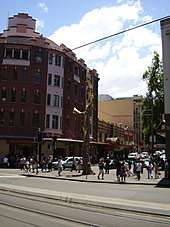Chinatown, Sydney
| Chinatown, Sydney | |||||||||||||||||||||||
 At Hay Street intersection, looking down Dixon Street | |||||||||||||||||||||||
| Chinese | 雪梨華埠 | ||||||||||||||||||||||
|---|---|---|---|---|---|---|---|---|---|---|---|---|---|---|---|---|---|---|---|---|---|---|---|
| |||||||||||||||||||||||
| Alternative Chinese name | |||||||||||||||||||||||
| Chinese | 悉尼唐人街 | ||||||||||||||||||||||
| |||||||||||||||||||||||
Chinatown (Chinese: 雪梨華埠 or 悉尼唐人街) is an urban locality in the southern part of the Sydney central business district, in New South Wales, Australia. It is located in Haymarket, between Central station and Darling Harbour. It is part of the local government area of the City of Sydney and is Australia's largest Chinatown.[1]
Location and history

The current location is the third in Sydney to be known as Chinatown. In the late 19th century, it was located in the Rocks area of Sydney and later moved to the area near Market Street at Darling Harbour. By the 1920s, it began to be established in its current location. Chinatown is centred on Dixon Street, a pedestrian street mall with many Chinese restaurants, and with a Paifang at each end. At the eastern side, running parallel with Dixon Street, are Sussex Street, which has a number of shops, and George Street, one of Sydney's main thoroughfares. At the eastern end of Chinatown, at the corner of George Street and Hay Street, there is a sculpture made from a dead tree trunk; created by artist Lin Li in 1999 and named Golden Water Mouth, it was said by its instigators to bring good fortune to the Chinese community. Other streets and lanes within Sydney's Chinatown include Factory Street, Goulburn Street, Little Hay Street, Kimber Lane and Thomas Street.

At the southern side of Chinatown, next to Hay Street, a large complex called Market City has been built, behind the walls retained from the site's old produce markets. It contains a modern shopping centre, restaurants (including an 800+ seat Dim Sum (Yum Cha) Restaurant called The Eight Modern Chinese Restaurant), boutique shops, City Amusements (a large indoor entertainment complex), and the Haymarket Paddy's Markets, a Wednesday-to-Sunday produce and flea market, as well as a large residential high-rise building called the Peak Apartments.
Unlike the Chinatowns in some other countries, Sydney's Chinatown has been relatively free of crime and hygiene issues. However, since there are many skyscrapers in Sydney, there are some concerns within the Chinese community about the building height restrictions imposed by the image-conscious local government authorities.
By the 1920s, Sydney's Chinatown migrated over to Campbell Street, and was then placed with the Capitol Theatre.
There are also satellite Chinatowns that have emerged in the past two decades in several Sydney suburbs such as Cabramatta, Ashfield, Hurstville, Eastwood, Campsie, Parramatta, Chatswood, Burwood, Flemington and Kingsford. But Sydney's Chinatown still remains a major focus for the Chinese Australian community.[2]
Sister cities
Sydney is the sister city of Guangzhou in China, and as a gift to Sydney during the Australian Bicentenary in 1988, the Chinese Garden of Friendship was constructed on the western border of Chinatown in the Darling Harbour Precinct. It is one of the few public traditional Chinese gardens outside of China.[3]
Bilingual street signs
 Factory St. 發多利街
Factory St. 發多利街 Goulburn St. 高賓街
Goulburn St. 高賓街 Hay St. 禧街
Hay St. 禧街 Kimber Lane 金貝里
Kimber Lane 金貝里 Little Hay St. 小禧街
Little Hay St. 小禧街- Liverpool St. 利物浦街
 Sussex St. 莎瑟街
Sussex St. 莎瑟街 Thomas St. 湯馬士街
Thomas St. 湯馬士街 Ultimo Rd. 歐廸模道
Ultimo Rd. 歐廸模道
Cultural depictions
Sydney's Chinatown is the setting and film location of the music video for David Bowie's 1983 single China Girl.[4]
See also
References
- ↑ "Chinatown and Haymarket". Sydney.com. Retrieved 6 June 2013.
- ↑ "Eastern promise spreads to the suburbs". The Sydney Morning Herald. 2002-09-06.
- ↑ "Chinese Garden of Friendship". Sydney Harbour Foreshore Authority. Archived from the original on 2 June 2013. Retrieved 6 June 2013.
- ↑ Davd Bowie dead at 69: The songwriter's time in Australia Daily Telegraph 12 January 2016
External links
- Shirley Fitzgerald (2008). "Chinatown". Dictionary of Sydney. Retrieved 26 September 2015. [CC-By-SA]
- SYDNEY.com - Chinatown and Haymarket
Further reading
| Wikivoyage has a travel guide for Sydney - City South. |
| Wikimedia Commons has media related to Chinatown, Sydney. |
- Fitzgerald, Shirley (1997). Red Tape, Gold Scissors (The story of Sydney's Chinese) (Paperback). State Library of New South Wales Press in association with The City of Sydney. pp. 206 pages. ISBN 0-7310-6607-3.
- Richards, D. Manning. Destiny in Sydney: An epic novel of convicts, Aborigines, and Chinese embroiled in the birth of Sydney, Australia. First book in Sydney series. Washington DC: Aries Books, 2012. ISBN 978-0-9845410-0-3
Coordinates: 33°52′43.61″S 151°12′14.69″E / 33.8787806°S 151.2040806°E